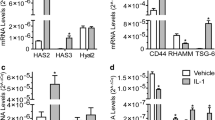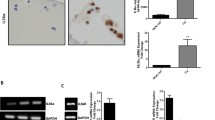Abstract
Beta-arrestin-1 (β-arrestin-1) is an adaptor protein that functions in the termination of G-protein activation and seems to be involved in the mediation of the inflammatory response. Interleukin-1β (IL-1β) elicits the expression of inflammatory mediators through a mechanism involving hyaluronan (HA) degradation, thereby contributing to toll-like receptor 4 (TLR-4) and CD44 activation. Stimulation of both receptors induces nuclear factor kappaB (NF-kB) activation that, through transforming-growth-factor-activated-kinase-1 (TAK-1), in turn stimulates the inflammatory mediators of transcription. As β-arrestin-1 seems to play an inflammatory role in arthritis, we have investigated the involvement of β-arrestin-1 in a model of IL-1β-induced inflammatory response in mouse chondrocytes. IL-1β treatment significantly increases chondrocytes TLR-4, CD44, β-arrestin-1, TAK-1, and serine/threonine kinase (AKT) mRNA expression and related protein levels. NF-kB is also markedly activated with consequent tumor-necrosis-factor-alpha, interleukin-6, and inducible-nitric-oxide-synthase up-regulation. Treatment of IL-1β-stimulated chondrocytes with β-arrestin-1 and/or AKT and/or TAK-1-specific inhibitors significantly reduces all parameters, although the inhibitory effect exerted by TAK-1-mediated pathways is more effective than that of β-arrestin-1. β-Arrestin-1-induced NF-kB activation is mediated by the AKT pathway as shown by IL-1β-stimulated chondrocytes treated with AKT inhibitor. Finally, a specific HA-blocking peptide (Pep-1) has confirmed the inflammatory role of degraded HA as a mediator of the IL-1β-induced activation of β-arrestin-1.








Similar content being viewed by others
References
Bartok B, Firestein GS (2010) Fibroblast-like synoviocytes: key effector cells in rheumatoid arthritis. Immunol Rev 233:233–255
Bhiloca S, Amin R, Pandya M, Yuan H, Tank M, LoBello J, Shytuhina A, Wang W, Wisniewski HG, Motte C de la, Cowman MK (2011) Agarose and polyacrylamide gel electrophoresis methods for molecular mass analysis of 5- to 500-kDa hyaluronan. Anal Biochem 417:41–49
Brennan FM, McInnes IB (2008) Evidence that cytokines play a role in rheumatoid arthritis. J Clin Invest 118:3537–3545
Campo GM, Avenoso A, Campo S, D’Ascola A, Traina P, Calatroni A (2009) Differential effect of molecular size HA in mouse chondrocytes stimulated with PMA. Biochim Biophys Acta 1790:1353–1367
Campo GM, Avenoso A, Campo S, D’Ascola A, Nastasi G, Calatroni A (2010) Small hyaluronan oligosaccharides induce inflammation by both toll-like-4 and CD44 receptors in human chondrocytes. Biochem Pharmacol 80:480–490
Campo GM, Avenoso A, D’Ascola A, Scuruchi M, Prestipino V, Calatroni A, Campo S (2012a) 6-Mer hyaluronan oligosaccharides increase IL-18 and IL-33 production in mouse synovial fibroblasts subjected to collagen-induced arthritis. Innate Immun 18:675–684
Campo GM, Avenoso A, D’Ascola A, Prestipino V, Scuruchi M, Nastasi G, Calatroni A, Campo S (2012b) Hyaluronan differently modulates TLR-4 and the inflammatory response in mouse chondrocytes. Biofactors 38:69–76
Campo GM, Avenoso A, D’Ascola A, Prestipino V, Scuruchi M, Nastasi G, Calatroni A, Campo S (2012c) The stimulation of adenosine A2 receptor reduces inflammatory response in mouse articular chondrocytes treated with hyaluronan oligosaccharides. Matrix Biol 31:338–351
Campo GM, Avenoso A, D’Ascola A, Scuruchi M, Prestipino V, Nastasi G, Calatroni A, Campo S (2012d) Adenosine A2A receptor activation and hyaluronan fragment inhibition reduce inflammation in mouse articular chondrocytes stimulated with interleukin-1β. FEBS J 279:2120–2133
Campo GM, Avenoso A, D’Ascola A, Scuruchi M, Prestipino V, Calatroni A, Campo S (2012e) Hyaluronan in part mediates IL-1beta-induced inflammation in mouse chondrocytes by up-regulating CD44 receptors. Gene 494:24–35
Campo GM, Avenoso A, D’Ascola A, Prestipino V, Scuruchi M, Nastasi G, Calatroni A, Campo S (2013) 4-Mer hyaluronan oligosaccharides stimulate inflammation response in synovial fibroblasts in part via TAK-1 and in part via P38-MAPK. Curr Med Chem 20:1162–1172
Campo GM, Avenoso A, D’Ascola A, Scuruchi M, Calatroni A, Campo S (2015) Beta arrestin 2 negatively modulates inflammation response in mouse chondrocytes induced by 4-mer hyaluronan oligosaccharide. Mol Cell Biochem 399:201–208
Cowman MK, Chen CC, Pandya M, Yuan H, Ramkishun D, LoBello J, Bhilocha S, Russel-Puleri S, Skendaj E, Mijovic J, Jing W (2011) Improved agarose gel electrophoresis method and molecular mass calculation for high molecular mass hyaluronan. Anal Biochem 417:50–56
Di Carlo EF, Kahn LB (2011) Inflammatory diseases of the bones and joints. Semin Diagn Pathol 28:53–64
Fan H, Luttrell LM, Tempel GE, Senn JJ, Halushka PV, Cook JA (2007) Beta-arrestins 1 and 2 differentially regulate LPS-induced signaling and pro-inflammatory gene expression. Mol Immunol 44:3092–3099
Gerlo S, Kooijman R, Beck IM, Kolmus K, Spooren A, Haegeman G (2011) Cyclic AMP: a selective modulator of NF-kB action. Cell Mol Life Sci 68:3823–3841
Jiang D, Liang J, Noble PW (2011) Hyaluronan as an immune regulator in human diseases. Physiol Rev 91:221–264
Lee HG, Cowman MK (1994) An agarose gel electrophoretic method for analysis of hyaluronan molecular weight distribution. Anal Biochem 219:278–287
Li J, Wei B, Guo A, Liu C, Huang S, Du F, Fan W, Bao C, Pei G (2013) Deficiency of β-arrestin1 ameliorates collagen-induced arthritis with impaired TH17 cell differentiation. Proc Natl Acad Sci USA 110:7395–7400
Li P, Cook JA, Gilkeson GS, Luttrell LM, Wang L, Borg KT, Halushka PV, Fan H (2011) Increased expression of beta-arrestin 1 and 2 in murine models of rheumatoid arthritis: isoform specific regulation of inflammation. Mol Immunol 49:64–74
Li Z, Potts EN, Piantadosi CA, Foster WM, Hollingsworth JW (2010) Hyaluronan fragments contribute to the ozone-primed immune response to lipopolysaccharide. J Immunol 185:6891–6898
Mitsiades CS, Mitsiades N, Koutsilieris M (2004) The Akt pathway: molecular targets for anti-cancer drug development. Curr Cancer Drug Targets 4:235–256
Mummert ME, Mohamadzadeh M, Mummert DI, Mizumoto N, Takashima A (2000) Development of a peptide inhibitor of hyaluronan-mediated leukocyte trafficking. J Exp Med 192:769–779
Powell JD, Horton MR (2005) Threat matrix: low-molecular-weight hyaluronan (HA) as a danger signal. Immunol Res 31:207–218
Shenoy SK, Lefkowitz RJ (2011) β-Arrestin-mediated receptor trafficking and signal transduction. Trends Pharmacol Sci 32:521–533
Sofat N (2009) Analysing the role of endogenous matrix molecules in the development of osteoarthritis. Int J Exp Pathol 90:463–479
Stern R, Asari AA, Sugahara KN (2006) Hyaluronan fragments: an information-rich system. Eur J Cell Biol 85:699–715
Sun JS, Wu CX, Tsuang YH, Chen LT, Sheu SY (2006) The in vitro effects of dehydroepiandrosterone on chondrocyte metabolism. Osteoarthr Cartil 14:238–249
Tanimoto K, Yanagida T, Tanne Y, Kamiya T, Huang YC, Mitsuyoshi T, Tanaka N, Tanaka E, Tanne K (2010) Modulation of hyaluronan fragmentation by interleukin-1 beta in synovial membrane cells. Ann Biomed Eng 38:1618–1625
Taylor KR, Trowbridge JM, Rudisill JA, Termer CC, Simon JC, Gallo RL (2004) Hyaluronan fragments stimulate endothelial recognition of injury through TLR4. J Biol Chem 279:17079–17084
Termeer CC, Hennies J, Voith U, Ahrens T, Weiss JM, Prehm P, Simon JC (2000) Oligosaccharides of hyaluronan are potent activators of dendritic cells. J Immunol 165:1863–1870
Termeer C, Benedix F, Sleeman J, Fieber C, Voith U, Ahrens T, Miyake K, Freudenberg M, Galanos C, Simon JC (2002) Oligosaccharides of hyaluronan activate dendritic cells via toll-like receptor 4. J Exp Med 195:99–111
Xie L, Qiao X, Wu Y, Tang J (2011) β-Arrestin1 mediates the endocytosis and functions of macrophage migration inhibitory factor. PLoS One 6:e16428
Xu X, Ito T, Tawada A, Maeda H, Yamanokuchi H, Isahara K, Yoshida K, Uchiyama Y, Asari A (2002) Effect of hyaluronan oligosaccharides on the expression of heat shock protein 72. J Biol Chem 277:17308–17314
Yang M, He RL, Benovic JL, Ye RD (2009) Beta-arrestin1 interacts with the G-protein subunits beta1gamma2 and promotes beta1gamma2-dependent Akt signalling for NF-kappaB activation. Biochem J 417:287–296
Author information
Authors and Affiliations
Corresponding author
Additional information
This study was supported by a COFIN 2009 grant from the MIUR, Italy (grant no. 20094C2H2M_003).
Rights and permissions
About this article
Cite this article
Campo, G.M., Avenoso, A., D’Ascola, A. et al. Beta-arrestin 1 is involved in the catabolic response stimulated by hyaluronan degradation in mouse chondrocytes. Cell Tissue Res 361, 567–579 (2015). https://doi.org/10.1007/s00441-015-2112-0
Received:
Accepted:
Published:
Issue Date:
DOI: https://doi.org/10.1007/s00441-015-2112-0




